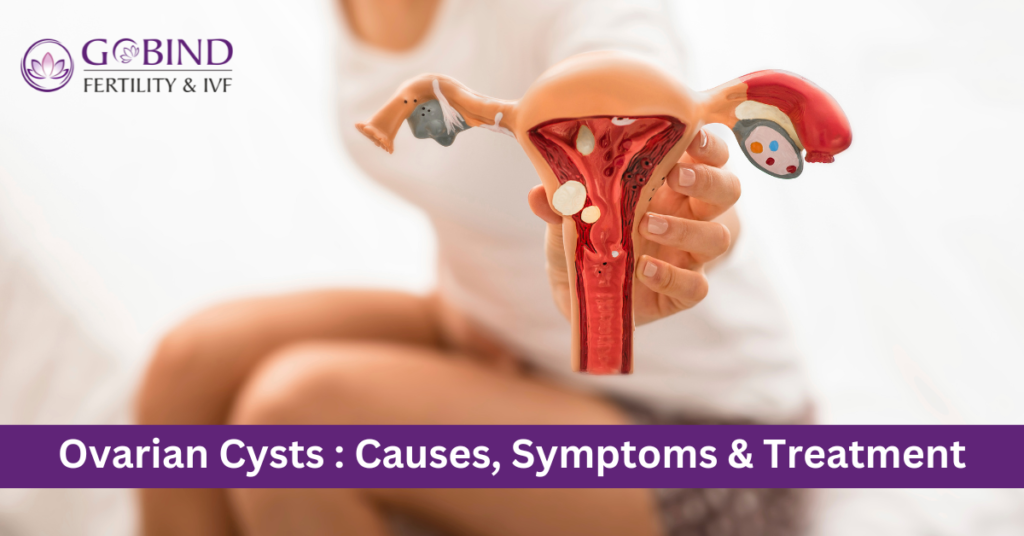Ovarian Cyst: Causes, Symptoms, and Treatment

Ovarian cysts are fluid-filled sacs or pockets that develop in or on an ovary. While many women experience an ovarian cyst at some point in their lives, the majority are harmless and resolve without treatment. However, some ovarian cysts can cause symptoms and complications, making it important to understand their causes, symptoms, and treatment options.
Causes of Ovarian Cysts
Ovarian cysts can develop for various reasons, often related to the menstrual cycle. The most common types include:
1. Functional Cysts: These are the most common type and occur as part of the menstrual cycle.
– Follicular Cyst: Develops when the follicle (which contains the egg) doesn’t rupture or release the egg but continues to grow.
– Corpus Luteum Cyst: Forms after the follicle releases the egg and the empty follicle sac doesn’t dissolve but reseals and fills with fluid.
2. Pathological Cysts: These are less common and occur due to abnormal cell growth.
– Dermoid Cysts: Also known as teratomas, these can contain tissues such as hair, skin, or teeth because they form from embryonic cells.
– Cystadenomas: Develop on the surface of the ovary and can be filled with a watery or mucinous substance.
Endometriomas: are caused by endometriosis, where endometrial tissue grows outside the uterus and attaches to the ovary.
3. Polycystic Ovary Syndrome (PCOS): A condition characterized by multiple small cysts on the ovaries, causing hormonal imbalances, and irregular menstrual cycles.
Symptoms of Ovarian Cysts
Most ovarian cysts are asymptomatic and discovered incidentally during routine pelvic exams or imaging studies. However, when symptoms occur, they may include:
– Pelvic Pain: This can be a dull or sharp ache in the lower abdomen, often on one side.
– Bloating and Swelling: A feeling of fullness or heaviness in the abdomen.
– Menstrual Irregularities: Changes in the menstrual cycle, including heavy periods, light periods, or spotting.
– Pain During Intercourse: Pain or discomfort during sexual activity.
– Urinary Symptoms: Frequent urination or difficulty emptying the bladder.
– Bowel Symptoms: Pressure on the bowels causing constipation or pain.
– Hormonal Symptoms: Changes in breast tenderness or hair growth patterns.
Severe symptoms that require immediate medical attention include
– Sudden, Severe Abdominal Pain: This could indicate a ruptured cyst or torsion.
– Fever: Suggesting an infection.
– Rapid Breathing or Fainting: Symptoms of shock from internal bleeding.
Diagnosis of Ovarian Cysts
Diagnosing ovarian cysts typically involves a combination of
1. Pelvic Examination: A physical exam where the doctor checks for swelling or tenderness.
2. Ultrasound: Imaging to visualize the cyst’s size, location, and composition (solid or fluid-filled).
3. Blood Tests: Including CA-125 to rule out ovarian cancer in postmenopausal women or those with complex cysts.
4. Laparoscopy: A minimally invasive surgical procedure to view the ovaries directly and sometimes remove the cyst.
Treatment of Ovarian Cysts
The treatment approach depends on factors such as the cyst’s size, type, and whether it causes symptoms. Common treatments include:
1. Watchful Waiting: Many functional cysts resolve on their own within a few menstrual cycles. Regular monitoring with ultrasounds may be recommended.
2. Medications: Hormonal contraceptives (birth control pills) can help regulate the menstrual cycle and prevent the formation of new cysts.
3. Surgery: Necessary if the cyst is large, persistent, causes severe symptoms, or if there is a concern about cancer. Types of surgical procedures include:
– Cystectomy: Removal of the cyst while preserving the ovary.
– Oophorectomy: Removal of one or both ovaries if the cyst is cancerous or recurrent.
4. Lifestyle and Home Remedies: Pain relief measures such as over-the-counter pain medications, applying heat to the abdomen, and maintaining a healthy diet and regular exercise.
Complications of Ovarian Cysts
While most ovarian cysts are benign, complications can arise, including:
– Ovarian Torsion: When a large cyst causes the ovary to twist, cutting off its blood supply, leading to severe pain and potential loss of the ovary.
– Rupture: A cyst that ruptures can cause severe pain and internal bleeding, posing a medical emergency.
–Infertility: Particularly with conditions like PCOS or endometriosis-related cysts. For every infertility problem, you can consult Dr Manju Khurana (IVF Specialist) at Gobind Fertility & IVF Centre in Hisar.
Ovarian cysts are a common gynaecological issue that most women will experience at some point. Understanding the causes, symptoms, and treatment options is crucial for managing this condition effectively. Regular pelvic exams and communication with a healthcare provider are essential for early detection and management, helping to prevent complications and maintain reproductive health.
